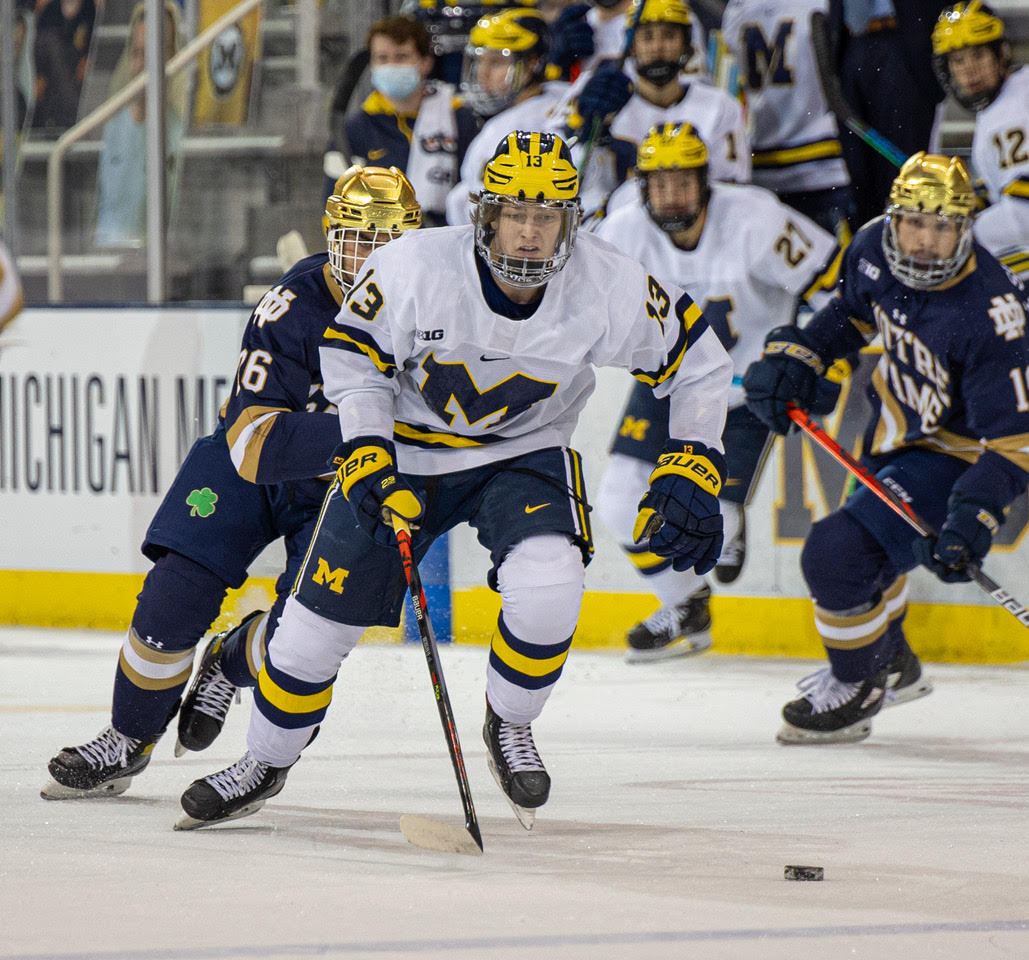The University of Michigan attracts some of the top hockey talent at the college level. Year after year, the Wolverines find themselves at the top of the Big 10 Conference and competing for a National Championship come springtime. Michigan has a history of producing successful NHLers, from Andrew Cogliano to Max Pacioretty.
Over the last few years, the Columbus Blue Jackets have established a connection with the University of Michigan, with a recent influx of draft picks and signings from “That School Up North” (from ‘That School Up North’, The Columbus Dispatch, 11/28/2014). This is a unique and maybe surprising relationship given the rivalry between Columbus-based Ohio State University and the Wolverines, but it is a partnership that should continue if the Blue Jackets want to improve their prospect pool.
Zach Werenski was first in the line of Wolverines turned Blue Jackets. The organization selected Werenski eighth overall in the 2015 NHL Entry Draft after his freshman year at Michigan. He played one more year for them before joining the Blue Jackets full-time in 2016-17. When he came onto the scene as a rookie, it was evident he had the potential to be a star. What was not so apparent was that he was just the first in a string of Wolverines with NHL potential.
Who Came Next?
Kent Johnson was the next former Wolverine to have his name called by the Blue Jackets, this time in 2021 as the fifth overall selection. Like Werenski, Johnson returned for his sophomore year after being drafted and joined the NHL club the following season. Undrafted defenseman Nick Blankenburg joined the Blue Jackets the same year as Johnson after signing as a free agent after his senior year at Michigan.

At the 2023 NHL Draft, the Anaheim Ducks decided to pass on Wolverine Adam Fantilli with the second overall pick, allowing the Blue Jackets to get the Hobey Baker Award winner third overall. Then, just 31 selections later, with the 34th overall pick in the second round, the Blue Jackets drafted forward Gavin Brindley also from the University of Michigan. Brindley plans to return to university for his sophomore year, but it wouldn’t be surprising to see him make the jump to the NHL this time next year. Overall, five players from Michigan are either currently on the Blue Jackets or were drafted by them.
Blue Jackets Inside Scoop
While the draft is not the same as free agency, and players do not have complete autonomy over where they end up, they do have some say in the matter. How? Through the draft interview process. Every season, throughout the winter and spring, NHL scouts and management personnel meet with potential draft picks. In these interviews, they discuss various topics about the prospect as a person and a player. The player being interviewed wants to make a good impression on the team and try to find a good fit.
Drafting Werenski in 2015 started a trend that has reaped benefits for the Blue Jackets on the ice, and I would argue it has had equal benefits off the ice. He can speak to prospects about the organization, while also providing insights to the Blue Jackets about the character of a potential prospect. He can help make sure the club is investing in the right people as future NHLers.

Of course, this doesn’t mean that Michigan prospects are guaranteed to be drafted by the Blue Jackets, just that familiarity could tip the scale in their favor. This inside connection has also helped the team select players late in the draft or sign them as free agents. NHL teams are always looking to draft players that are good fits for their organization. It is less about their pre-draft ranking or projected round as they get deeper into the draft. Likewise, with free-agent signings, players have a choice in who they play for, even if it’s limited.
Blankenburg is a great example, as the former Wolverine captain was coming off an excellent senior season where he recorded a career-high 29 points while leading his team to the NCAA Frozen Four. After such a strong campaign, it is likely he had a few NHL teams interested in signing him, despite going undrafted. Selecting the Blue Jackets could easily have been thanks to his relationship with Johnson.
Why Michigan?
There are many reasons why the Blue Jackets have become a landing spot for prospects from “That School Up North.” Outside of Michigan’s ability to produce top-level talent, there are other factors at play.
First, the proximity between Ann Arbor and Columbus benefits both parties. The NHL club can keep close tabs on these prospects leading up to and after the draft and help them build closer relationships over time to help their development. Players want to play for organizations where they will feel supported, while organizations want to attract players who will thrive in their environment. The ability to build this relationship early on is vital.
Related: Blue Jackets Who May Struggle Under Mike Babcock
Second, there are similarities between the two cities. Both are big college towns that offer a similar lifestyle. Whether considering signing a contract or extending one, quality of life matters. Although players at the University of Michigan are not professional athletes if they enjoy life in Ann Arbor, it’s likely they’ll also enjoy life in Columbus, which might be a factor when they are thinking about joining the club.
Impact on the Blue Jackets
This unofficial “affiliation”, if we can call it that, between the University of Michigan and the Blue Jackets and the success of these five players will be worth keeping an eye on. Should Werenski and Blankenburg continue to log big minutes on the team, and Johnson and Fantilli thrive with the team, Columbus will continue to be a destination for Wolverines.
